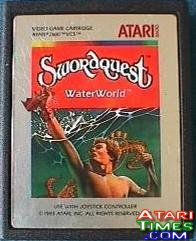 |
 |
Built To Last |
The Nintendo 64 may very well be the last cartridge-based console ever seen, as manufacturers are giving up on the costly format in favor of the cheaper-to-produce compact disc. What this means for the future appears to have been overlooked - gamers raised on CD-based systems such as the PlayStation and Dreamcast will probably not be able to enjoy their own version of "classic gaming" that those raised on cartridge-based systems such as the Atari 2600, 5200 and 7800 do today. Yes, they may be able to relive their youths through the wonder of "emulation," but like masturbation, it's a poor and ultimately unsatisfying substitute for the real thing.
 For the first part, it's unlikely the hardware will survive. A more than 20-year-old 2600 pulled from a shed and filled with dirt, dead
insects and cobwebs can be cleaned out, plugged in and works; a rock can be popped out of the cartridge port of a 7800 and the
machine will function. More sensitive hardware such as the PlayStation would probably be reduced to a paperweight by such neglect.
The durability of Atari's hardware in particular is well known, whereas the flakibility of hardware such as the original Nintendo
Entertainment System is equally known - one particle of dust gets in its cartridge port and kablooey.
For the first part, it's unlikely the hardware will survive. A more than 20-year-old 2600 pulled from a shed and filled with dirt, dead
insects and cobwebs can be cleaned out, plugged in and works; a rock can be popped out of the cartridge port of a 7800 and the
machine will function. More sensitive hardware such as the PlayStation would probably be reduced to a paperweight by such neglect.
The durability of Atari's hardware in particular is well known, whereas the flakibility of hardware such as the original Nintendo
Entertainment System is equally known - one particle of dust gets in its cartridge port and kablooey.
But even if the hardware for CD-based systems was to survive, its software is it's Achilles heel - it doesn't take much to render a compact disc, music or data, unreadable and useless. Today's classic gaming owes much of its existence to its very format, the cartridge. A CD could never withstand the kind of abuse a cartridge can take and still function. While there's a well-known Internet account of a 2600 cartridge exposed to various extremes - fire, boiling, and microwaving among a few - and still working afterwards, cartridges are likely to encounter and survive through the simple ravages of time, poor environment and neglect.
Any collector of Atari game cartridges need have two items handy - rubbing alcohol and cotton swabs. When cartridges are found at flea markets, yard sales and second hand stores, or even bought online, they are likely to have seen better days. They're gonna be dirty, or worse. They may still have a label, or part of a label or none at all. Any Atari collector who values his consoles should never plug in a new acquisition until after a thorough cleaning.
The "door" system employed by Atari on 2600 and 5200 cartridges has helped ensure their survival by protecting them from the elements. For those unfamiliar, these cartridges had a spring-loaded door-like device that kept the chip concealed until inserted into its console - male ends on either side of the cartridge port of the console would move corresponding latches on the cartridge, raising a door over the chip.
But for any old cart, door or not, a cleaning with an alcohol-dipped cotton swab will turn the swab black and the contacts a glittering gold. Cartridges with exposed chips are likely to need more attention, but it is a rarity for cartridges for any Atari system not to function - a 5200 cartridge with corroded contacts may not work after simply being cleaned, but after several insertions and removals from a console, it will begin to work again; a 2600 cartridge covered inside and out with green mold and a decayed label can be opened up, cleaned, put back together and rendered functional again.
And there's another advantage to cartridges - the cartridge itself. It can be held and felt. The Atari 2600 and 7800 cartridges are beautiful in their simplicity, while their label art is, well, art. The 5200 cartridges impress by their size, like the gigantic console for which they were made. One can admire and compare the differences among manufacturers - Activision, Imagic, Sega, Parker Bros., Coleco and others all had their own unique, signature cartridge design. The really avid will note variations in labels. By comparison, a compact disc is just another compact disc - they're all the same, and be sure to hold them by the edges. In a way, one could say the cartridges were as unique and interesting as the games themselves, just as today's CDs are as common and boring as many of the fighting and racing games they contain.
The technology may be outdated, but it was built to last. While some may only want to acquire cartridges in mint condition, with
perfect labels, there's satisfaction to be found in rescuing these dirty and battered cartridges, and consoles, from oblivion. While
classic games can be played on computers with emulators, there's just no substitute for grasping a cartridge, putting it in the
console, turning on the power, and being drawn into your television as you first were so many years ago.
| Name: | |
| Subject: | |
| Comment: | |
| Check: | What is the greatest video game company of all time? (Hint: Atari.) |